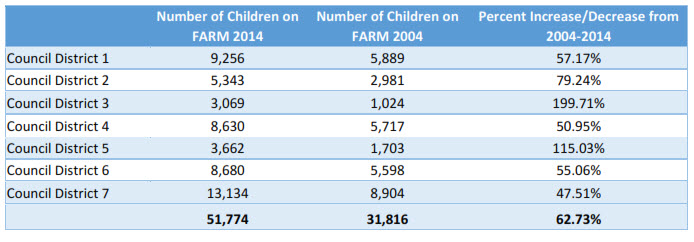Increasing Relevance - What Community Conservation Means for NeighborSpace
$54,000,000. That's the price tag for solving the problem of food insecurity experienced by 105,000 county residents, about 13% of Baltimore County's population. According to the U.S. Dept. of Agriculture, food insecurity occurs when there is a limited or uncertain availability of nutritionally adequate and safe foods or limited or uncertain ability to acquire acceptable foods in a socially acceptable way.
For many people who are food insecure, paying for utilities, transportation, housing, and medical care drains the household budget, leaving little or nothing with which to purchase healthy foods, as shown in the diagram below. Believe it or not, Baltimore County has a higher rate of food insecurity than 15 of Maryland's 24 counties. It's a huge problem, with the County Council having passed a resolution earlier this year creating a Food Policy Task Force to significantly improve public health, food security, and community well-being by creating systemic change to the local food system, among other things.

Image Credit: Feeding America 2015, www.feedingamerica.org
NeighborSpace's journey down this path began when it was invited to participate in the Land Trust Alliance's Land Trust Leadership Program for 2013-2015, a selective training opportunity for land trust executive directors and board members designed to help viable leaders take the work of their respective land trusts to the next level. Among the conservation tenets discussed as part of the program was "community conservation," an inclusive approach to land conservation that begins by listening and responding to many different voices in the community and that uses the power and expertise of the land trust to address expressed community needs. Often, land trusts collaborate with new and sometimes unexpected partners and this inclusiveness builds respect and trust, strengthens conservation, and broadens public support for a shared mission that benefits the entire community. If implemented successfully, community conservation allows a land trust to use its lands to solve pressing local problems and access new streams of philanthropic support.
NeighborSpace received a grant of $2000 from the Land Trust Alliance at the end of its participation in the Leadership Program to study ways of improving its relevance to the communities it serves and enhancing its capacity. We hired an intern to help Executive Director, Barbara Hopkins, study three possible areas where our lands might be used to address pressing local problems, among them (1) affordable housing; (2) food insecurity; and (3) disconnected youth. At its March 2016 meeting, the board reviewed the completed study, available here, and decided to pursue food insecurity, as well disconnected youth, while electing to engage in further study about affordable housing.
Food insecurity in Baltimore County is only worsening with a startling number of Baltimore County public school students participating in the Free and Reduced Meals Program (FARM). This federal program provides free or reduced priced meals to students based on household size and income, with the income threshold set a 185% of the federal poverty level. In four of seven Councilmanic districts, a majority of schools have 50% or more of their students receiving FARM. As shown in the table below, across the Councilmanic districts, the number of children on FARM increased by 63% between 2004 and 2014.
|
Number of Children on FARM 2014
|
Number of Children on FARM 2004
|
Percent Increase/Decrease from 2004-2014
|
|
|
Council District 1
|
9,256
|
5,889
|
57.17%
|
|
Council District 2
|
5,343
|
2,981
|
79.24%
|
|
Council District 3
|
3,069
|
1,024
|
199.71%
|
|
Council District 4
|
8,630
|
5,717
|
50.95%
|
|
Council District 5
|
3,662
|
1,703
|
115.03%
|
|
Council District 6
|
8,680
|
5,598
|
55.06%
|
|
Council District 7
|
13,134
|
8,904
|
47.51%
|
|
51,774
|
31,816
|
62.73%
|
Table Credit: NeighborSpace board member, Dr. Laurie Taylor-Mitchell
Our research revealed that several factors have made food insecurity a pressing problem in the County, among them the high cost and low accessibility of nutritional food options, particularly in the census tracts highlighted below.

Other land trusts have made inroads on the problem with community gardens, community supported agriculture programs (CSAs), farmers' markets, and projects educating youth about food production, with this latter idea providing a way of linking the food insecurity and disconnected youth challenges. The board has established a small committee to further research the types of programs and potential sources of funding for programming to tackle these issues. As the work evolves, we will make materials available to the public on this web page.